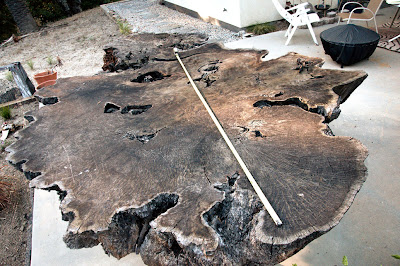In preparing for an upcoming show, I was casting about for ideas of what to make that was new and different, and I remembered that I had designed a room divider/screen for the Legacy Redwood project that I've written about over the past few years. So after consulting with the client to get the OK, I went for it with the screen.
This piece was designed to take advantage of the unique shape of one of the slabs that we had that included an interesting void from an old burn scar ...
Not surprisingly, as the slices came off, they did, indeed, start to fall apart as we lifted them. But I managed to get them back to the shop with their pieces taped together and then went about stabilizing them.
To give these slices some structural stability I basically soaked them in epoxy. First, the pieces were assembled in their correct places, then the whole slice was covered with self-adhesive carpet protector film, to act as a giant piece of tape.
The slice was then flipped over and two-part epoxy was simply poured over the entire slice and allowed to soak in. Just as in finishing with oil, as the epoxy soaked into areas and became dry, more epoxy was poured on.
After the epoxy set, the film was removed, the slice was flipped, and more epoxy was poured onto the second side. In the photo below, you can see the slice on the left has been partially sanded.
The epoxy did a great job stabilizing the slices. So then it was just a matter of making the frames and assembling.The frames are made of quartersawn sapele (a type of African mahogany), and the lower panels are redwood burl from one of the other chunks in this project.
The two halves of the screen are articulated with solid wenge hinge blocks.
And the natural edges of the redwood slices are held in place with stainless steel pins.
All in all, it weighs a ton (80 lbs, to be precise) , but I think it turned out rather well.
For more photos of the finished piece, check out the shop's Facebook page in the near future.



















































